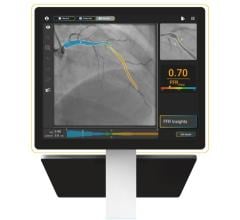
The Medrad/Bayer Avanta system.
Automated contrast media injectors are used in cardiac imaging to help improve patient safety and enhance image quality. These devices control contrast dosage, record the amount used, speed injections to keep up with fast CT scanners, and warn of potential hazards, such as air embolisms or extravasations.
Key Differences in Injectors
Angiography uses single-head injectors with one syringe, while computed tomography (CT) systems use a dual-head injector with two syringes. CT injectors use venous access, so air embolisms are not a major issue, because any small bubbles are expelled through the lungs, said Carter Newton, M.D., FACC, assistant professor of radiology, assistant clinical professor of cardiology, University of Arizona Health Sciences, Tucson. Angiography systems inject contrast into arteries, where air embolisms are a serious risk. For that reason, many cath lab injectors have air embolism detectors. In the interventional suite, power contrast media injectors are commonly used to achieve opacification for diagnostic procedures. CT imaging studies usually require high-flow, high-volume, fixed rate injections delivered with relatively high pressures. However, in the interventional suite, procedures need low, variable flow rate injections. Injectors used with magnetic resonance imaging (MRI) are engineered to prevent electrical interference in the magnetic field. They use a hydraulic control system or include shielding of the electrical controller.
Injectors Offer Advantages in CT
When CT contrast injectors were first introduced about 20 years ago, single-head angiography injectors from the cath lab were employed, Newton said. However, dual-head injectors specifically for CT have since replaced those devices. The double syringes allow a large, fast initial bolus of contrast and a second syringe filled with a follow-up saline-contrast flush to keep the contrast flowing in the body. “The key advantage is you can optimize the bolus injection into one or more phases,” Newton said. In cardiac CT, a quick injection is needed to image both sides of the ventricular septum. This helps identify shunts, septal thickness and enlarged ventricles. The contrast delivery is more controlled and efficient when using a dual-head power injector, Newton said. They also are required with the extremely quick imaging times now possible with new multidetector CT scanners.
Workflow Improvements
Automated injectors allow the injection rate to be programmed and provide other features to aid clinicians. Newton said some offer extravasation sensors to warn if the injector needle is imbedded in tissue instead of inside the vessel. “It takes out all the uncertainties,” he said. Injector control of contrast delivery timing can also be leveraged to optimize imaging. If timed properly, Newton said it could help limit the number of scans necessary by eliminating the need for repeats because of problems with insufficient contrast delivery. Data management systems offered for some injectors provide data to measure workflow efficiencies, imaging optimization and patient safety.
The systems can also integrate preprogrammed multidetector CT protocols. Other features may include auto initialize, auto fill and auto purge features and air embolism protection.
Angio Contrast Dose
Automated contrast injectors were first introduced in the cath lab to conserve contrast media, Newton said. Today, contrast dose is a patient safety concern, particularly in those with renal impairment. The iodine-based agents used in angiography and CT can cause contrast-induced nephropathy (CIN). Automated injectors help physicians monitor the dosage and set the precise amount of contrast used for each injection. Users say manual devices do not allow for meticulous control of the flow rate, amount and peak pressure. About seven years ago, the Krannert Institute of Cardiology in Indianapolis converted from manual to power cath lab injectors. Since the migration, contrast use dropped about 60 percent.
“That was a huge change in our practice,” said Jeffrey Breall, M.D., director, cardiac catheterization laboratories and interventional cardiology, Krannert Institute of Cardiology, Indiana University, Clarian Health. “Our number of contrasted-induced nephropathy cases dropped significantly. I think it is an expense that is well worth it,” he explained. Krannert and Clarian physicians use Acist power injectors that automatically capture contrast usage information, which is used to create a report. Breall said the staff is now well accustomed to interacting with the device and individualizing the various controls to optimize the images while minimizing the contrast.
“The one-time upfront cost for the injector system pays for itself in no time,” Breall said. The opacification and clarity using the Acist device in combination with 4 French catheters is every bit as good as that seen with 6 French catheters [required for the former manual injectors. With the smaller catheters] we have also saved thousands of dollars on closure devices for diagnostic cases.”
Medrad’s Avanta injection system provides similar functionality in the cath lab. It offers fixed or variable flow contrast and saline delivery on demand, replacing the manual manifold and syringe. The system can help improve workflow and reduce contrast consumption.
Comparing Contrast Media Injectors for CT and Angiography
This article served as an introduction for a comparison chart of specifications for contrast media injectors used for CT and angiography systems. The chart, Contrast Media Injectors, can be accessed at www.dicardiology.com/content/contrast-media-injectors. Access requires a login but it is free and only takes a minute to complete.
For additional information, read the article "Recently Introduced Contrast Injectors."
Read the 2015 article “Latest Trends in Contrast Media Injectors.”
Read the latest updates from 2016 “Latest Advances in Contrast Media Injectors.”


 October 24, 2025
October 24, 2025 









